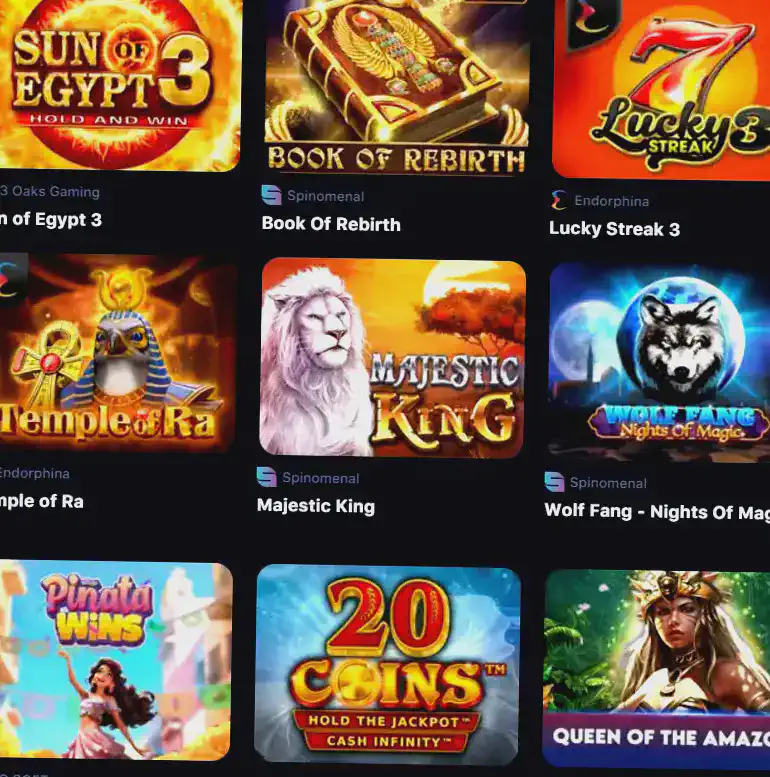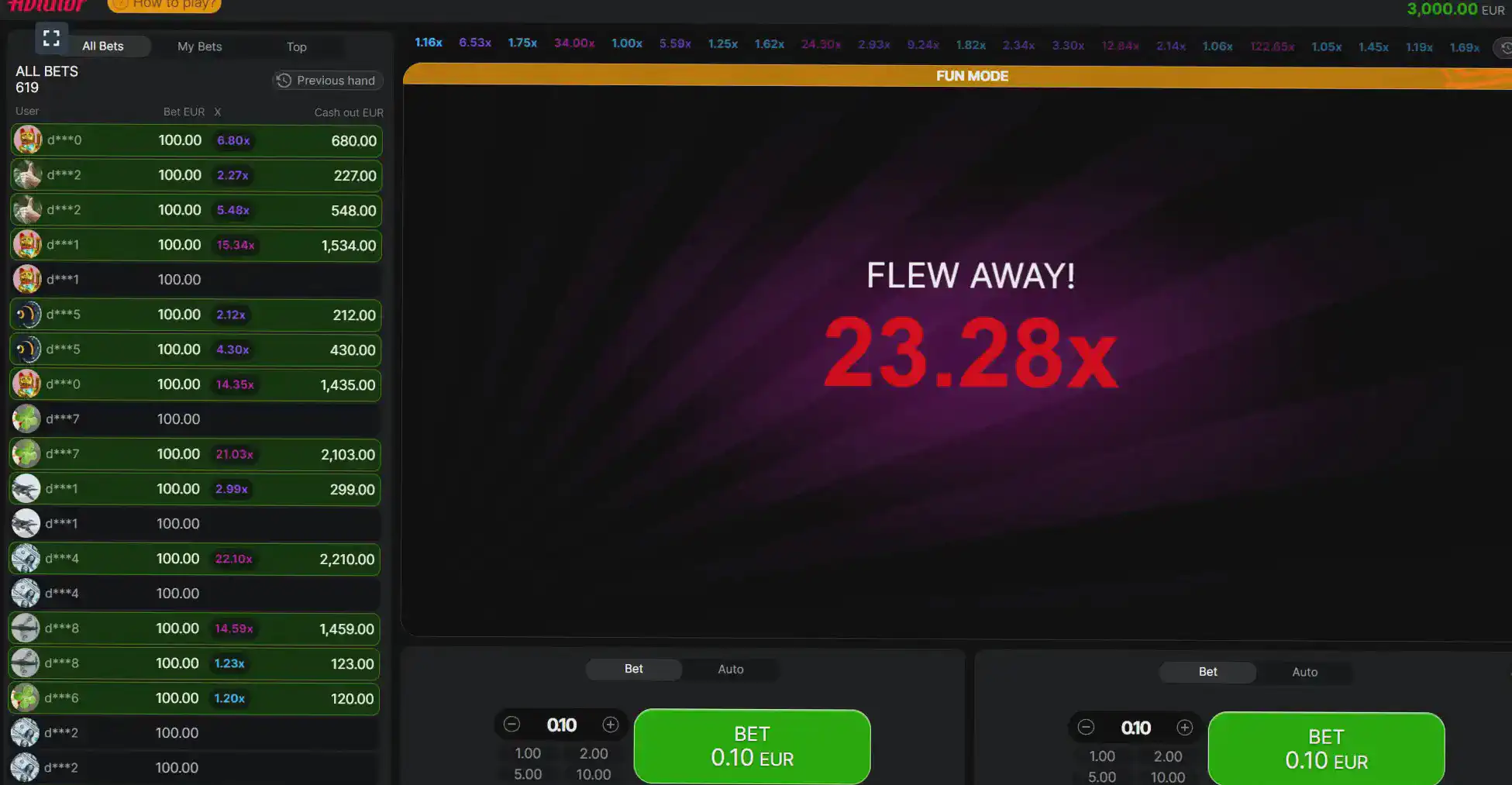Lucky Star Casino Review
LuckyStar is a leading online casino in Cote-d’Ivoire that attracts attention with its classic design and wide functionality. Players can access the platform through the official website, launching it from any browser on their device. Both mobile and desktop versions of the site are available, which opens up wide opportunities for gambling fans.
The Lucky Star casino lobby offers a wide range of gambling games. You will find more than 8,000 games from leading providers. Enjoy unique games from BetSoft, Quickspin, Microgamig and other developers. Explore the catalog of gambling games yourself to try all the available features with minimal costs.
Despite the fact that the site was launched relatively recently, it has already found its fans. Many users appreciated the convenience of the interface, round-the-clock support and a wide range of promotions. The 500% welcome bonus on the first deposit and 30% cashback are worth paying attention to.
Overview

LuckyStar casino operates under a Curacao license, so it inspires a high level of trust. The platform is ready to offer its players security and privacy in accordance with established standards. Players from Cote-d’Ivoire can use local payment systems for deposits and withdrawals. They can also enjoy pleasant crash, table games, and classic slots. A wide range of themes and gameplay options allows everyone to choose the best game option in accordance with individual tasks. In the tables below, you can see all the characteristics of the platform.
| Column | Description |
|---|---|
| 📅 Year of Establishment | 2023 |
| 💼 Owner | Lucky Star |
| 🏢 Headquarters | Curacao |
| 📜 Licence | Curacao, License No. 8048/JAZ2018-040 |
| 🎁 Key Offerings | 500% on the first deposit, 30% casino cashback |
| 📞 Customer Support | Live chat, e-mail |
| 💱 Accepted Currencies | EUR, USD, HKD, USDT, Litecoin, Dogecoin, Ethereum, BNB, Ripple, Qtum, Zcash, Dash and others |
| 📱 Mobile App | Android and iOS |
| 🛡️ Security | SSL |
| 💲Payment Options | E-wallets, bank and credit cards, cryptocurrencies, bank transfers |
| Rating | Appraisal |
|---|---|
| Overall assessment | 4.6/5⭐ |
| Output speed | 4.8/5⭐ |
| Bonuses and offers | 4.7/5⭐ |
| Safety and regulation | 4.9/5⭐ |
| Software and games | 4.8/5⭐ |
| Reliability | 4.9/5⭐ |
Lucky Star login and registration in Cote-d’Ivoire

Getting started on the platform is very simple and does not present any difficulties. All adult players from Cote-d’Ivoire can register. Also, users must meet certain requirements. Each player has the right to register only one profile. If a player is somehow cheating, this can be easily detected during the verification process. Everyone must upload a passport, driver’s license or any other document for identification. It is also necessary to confirm the residential address by sending a payment.
Players can subscribe to the newsletter by leaving an email address. With the help of the newsletter, users will be able to find out the latest news, updates, promotions and much more. All these precautions are necessary to ensure the safety of each registered player and the safety of their personal data. When registering, you can be sure that the data is not transferred to third parties. All information is strictly confidential, and payment data is protected by SSL algorithms.
Registration
Lucky Star registration is the first step to becoming a full-fledged part of the gambling platform and joining an actively developing gambling community. Only players with registered accounts get access to all bonuses, exclusive offers and gambling games. Every adult user can register in Cote-d’Ivoire and start managing their finances with minimal costs. You can log in to your personal account at any convenient time. To register, you will need to complete the following simple but necessary steps:
- Open a browser on any of your devices. Enter the address of the online casino website in the address bar. Make sure that you enter the correct address. If necessary, use a VPN to access the resource.
- The main page of the online casino will appear in front of you. Find the registration button on the screen. You can see it in the corner of your display. You will see a registration form for registration.
- Select a registration method: through social networks or by filling in all the data. In the first case, you need to specify one of the available social networks and log in through it. In the second case, you need to fill in all the empty fields of the form: enter your email address, password, phone number. Select the account currency. Enter a promo code if necessary.
- Read the terms and conditions of the user agreement. Only after carefully reading all the terms, confirm your consent by clicking on the appropriate button.
- Click on the button at the bottom of the registration form to complete the procedure.

After completing all the listed actions, you will be automatically authorized in your personal account. Get access to all the features of the online casino with Lucky Star login as a registered user and take advantage of all the available privileges that the platform offers.
Login
Use Lucky Star casino login and password to log in to your personal account. After registration, you can log in to your personal account at any time and gain access to all gambling games and financial management. Follow these simple step-by-step instructions if you want to log in to your personal user account and play for money:
- Open the main page of the online casino in any way convenient for you. Carefully check if you are following a valid link.
- Find the authorization button, which is located next to the registration. You will see a form for authorization in the online casino.
- Fill out the form that appears. Specify your Lucky Star Aviator login and password specified during registration. Carefully check the correctness of the entered data.
- Click on the button at the bottom of the screen to log in to your personal account.
You will be automatically redirected to the main page of the online casino. Now you have full access to all functionality. You can make a deposit and withdraw money. Only pre-registered players must undergo mandatory verification. This is necessary to confirm your identity and reduce the risk of fraud.
For verification, you will need to upload a passport or any document to confirm your identity. Scan the documents and send them to the online casino administration by email. Verification takes several business days. After that, you will receive a notification about the successful completion of all checks. Now you can easily start playing for real money and enjoy all the privileges of registered players.
Lucky Star welcome bonus

The welcome bonus is what all new players receive. The welcome bonus is 500%. It is divided into 4 first deposits. This allows players to increase their bankroll and increase their potential winnings with minimal restrictions.
So, for example, you made your first deposit of 110 000 XOF. In this case, you will receive a 200% bonus, and the amount in the bonus account will be 220 000 XOF. This money can be used for betting in the online casino only on certain games. So, it can be used on games from the Slots and Top Games section. Perhaps, over time, the possibilities of the casino’s welcome offer will be expanded.
How to receive
So, the question arises, how can players get a welcome bonus? You don’t need to do anything complicated for this. The welcome offer is credited automatically to all newcomers who make their first deposit. Follow this simple guide:
- Go to the online casino website. Follow the registration procedure according to the instructions described above. Log in to your personal account.
- Click on the Deposit button, which is located next to the user icon. Check the available payment methods in Côte-d’Ivoire. Choose the option that suits your preferences. Make your first deposit. Specify the payment amount and details for the transaction.
- Receive your welcome bonus. Immediately after the first money is credited to the account, the player receives money on the bonus account.
- Go to the Casino section and start playing for real money in available gambling games from the catalog that meet the bonus conditions.
Play slots and games, use available online casino bonuses to increase your bankroll and start playing for real money with minimal costs. Welcome bonus is a good opportunity to start quickly and with small personal investments. Welcome bonus allows you to try many gambling features and test different tactics before using large bets.

Wagering requirements
The welcome bonus has certain rules and conditions according to which it must be wagered. It is important to adhere to all these gambling conventions in order to get the most out of the welcome bonus. Please note the following recommendations:
- bonus money is credited to the account only after the player’s first deposit;
- only new and only registered online casino players can receive the welcome bonus;
- before receiving the welcome bonus, you must go through the verification procedure;
- money is necessarily credited to the bonus account;
- after the money runs out on the main account, money is transferred from the bonus balance for gambling;
- you can use the welcome bonus on games from the Slots and Top Games categories.
The maximum amount within the welcome bonus is 550 000 XOF. The welcome bonus will help beginners learn more about all the online casino games and enjoy the gaming process to the fullest.
Cashback offer
You can use not only Lucky Star casino free play with a welcome bonus. Already registered players can take advantage of a pleasant cashback to get the lost money back to their account. The maximum cashback amount is 30%. This is a great opportunity to return a considerable amount of money from the loss in a week. At the same time, it is very important to be an active player, regularly make deposits and bet money in online casino games.
How to receive
Cashback can be received by every registered player in an online casino if they start playing. You don’t need to perform any complicated actions to do this. Simply log in to your personal account and start playing by following these simple instructions:
- Go to the online casino website and log in to your personal account if you haven’t done so yet.
- Top up your account in your personal account using one of the available methods.
- Go to the casino lobby and start betting money. Play actively.
- Get your nice cashback every week. The more you play, the more cashback you get to your account.
Use Lucky Star casino free play promo codes to make gambling even more accessible and interesting for yourself. Take advantage of the available bonus offers on the website to enjoy gambling on more favorable terms.

Percentage
Every registered player can get cashback if he/she actively plays and places bets. To get cashback, you need to make deposits and play in the casino. The larger the bet amounts made per week, the greater the cashback you will receive, up to 30%. In the table below, you can see the cashback amounts.
| Cashback, % | Sum of bets for 7 days, F CFA | Maximum cashback, F CFA |
|---|---|---|
| 1 | 750 000 | 22 000 |
| 2 | 2 200 000 | 30 000 |
| 3 | 3 700 000 | 37 000 |
| 4 | 5 900 000 | 59 000 |
| 5 | 7 400 000 | 112 000 |
| 10 | 74 000 000 | 150 000 |
| 20 | 150 000 000 | 225 000 |
| 30 | 370 000 000 | 370 000 |
Loyalty program
LuckyStar.com is a developing platform that values each of its players, offering the most favorable conditions for the gaming process for everyone. The loyalty program was developed specifically so that all users could get the most out of gambling. Thus, the online casino offers to collect Lucky Coins. These are coins that can be exchanged for real money. To get coins, you need to regularly place bets in gambling games on the platform. The more active you are, the larger the bonus amounts you can receive and increase your potential winnings.
How to earn Lucky Coins
All registered players can start earning Lucky Coins in the online casino. Make regular bets on the site. Play popular slots and other gambling games. Follow these step-by-step instructions to take part in the loyalty program:
- Open the official LuckyStar casino website and log in to your personal account.
- Make a deposit in any available way. If you have money in your account, proceed to the next step.
- Go to the casino section and place bets. Play actively throughout the week.
- Collect coins for your bets and achievements. Track your progress in your personal account.
- After you collect the required number of coins, exchange them for real money at the current rate.
Take advantage of the unique offer of LuckyStar casino as part of the loyalty program. Such a program is created specifically to encourage the most active players and provide them with increased bonuses. Play slots and the best gambling games on the platform to collect Lucky Coins.
Exchanging coins for real money
Lucky Star casino online requires certain conditions to be met in order for players to be able to exchange coins for real money. Thus, it is necessary to make at least 6,000 bets in online casino games. To do this, you need to actively play and place bets for money. Also, pay attention to the current exchange rate. For 1,000 collected coins, the player receives 8,000 XOF. Carefully read all the features and the exchange rate before using the coins.
Lucky Star bets
Lucky Star sports betting is not yet available on the platform, but this feature may appear over time. Despite the lack of such an opportunity, players have something to do. They can choose from various gambling options from trusted providers. The site offers a wide range of slots and table games from the most famous world providers that deserve recognition.
Lucky Star Côte-d’Ivoire is actively developing and regularly replenishes the library of gambling games to make the catalog even more diverse for players. All games have a bright and modern design, comply with the rules of fair and safe play. You can be sure that all Lucky Star bets will bring maximum benefit in case of victory. Intuitive controls, stylish design and many bonus features await players even without sports betting.
Lucky Star casino games

The catalog presents a wide range of Lucky Star games, which are distinguished by the high quality of the gaming process. All games have a bright design and wide functionality. In addition, they have a variety of themes from classic fruits to the most complex story games of any complexity.
The casino assortment has more than 8 000 slots, table games, crash games, which make it possible to reveal the potential of each player and spend time with maximum benefit. The range of gambling games is regularly replenished with new items. This makes it possible to constantly experiment and choose the best gambling games from the catalog in accordance with individual preferences. Among the most prominent game developers are the following:
- Play’n GO. The oldest gambling provider is ready to offer only its best and most advanced slots, distinguished by the high quality of the gaming process. They comply with the technology of provable fairness. The subject matter is diverse. Thus, you can play Pearls of India and other famous slots of the provider on the casino website;
- Quickspin. The provider constantly offers to play a variety of new products. Interesting slots with unique dynamics and functional gameplay appear regularly. Eastern Emeralds and Book of Inferno attract the attention of true fans of gambling;
- NetEnt. This is a real legend in the world of gambling. The provider develops high-quality slots that have earned the recognition of many fans. Gonzo’s Quest is a top slot of the provider that deserves attention. There are also other interesting games that attract large multipliers, bonus symbols and other advantages.
Lucky Star jeu deserves recognition. A wide range of offers will not leave anyone indifferent. Some of the games in the range can be tried for free in a demo. This allows everyone to reduce costs on bets and optimize their gameplay, mastering the controls and other subtleties.
Slots

Slots are a classic category of gambling games that attract attention with their diversity. This is not surprising. The Lucky Star website features more than 7,500 slots from global providers. This allows everyone to choose the best gambling game for their preferences. Among the popular slots in this category are the following:
- Mirror Joker (Play’n GO). This is a retro game that attracts attention with its modern vibes and simple gameplay. RTP is 96.2%, which is above average and allows you to return most of the bet. The game includes expanding multipliers, wild symbols and other nice bonuses.
- Wild Cash (BGaming). The player can potentially get 999x of the initial bet. This is a classic slot machine that attracts attention with its fruit theme. The symbols are familiar to everyone. Here you can find lemons, cherries, sevens for luck and much more. The controls are as simple and intuitive as possible, so even beginners will not have any difficulties.
- Majestic King (Spinomenal). The slot machine has a classic layout and includes 25 paylines. Wild animals are used as symbols. Players can get free spins, use special symbols and even activate a bonus round. Medium volatility ensures that you will win in most cases.
- Wild West TRUEWAYS (BGaming). The game has high volatility. The slot includes many ways to win. RTP is 96.84%, which allows everyone to get a nice win in case of a win. In addition, players can win the jackpot and take advantage of nice multipliers of their winnings.
- 3 China Pots (3 Oaks Gaming). This is an Asian-themed game that is very popular among users. Thus, users can get nice bonuses, as well as get an incredible experience during the game.
A wide range of slot machines gives every player the opportunity to enjoy incredible gambling and have fun. Lucky Star offers everyone the opportunity to choose a suitable game option from a wide range.

Crash games
At the moment, users can play 18 crash games on the site. The classic genre Lucky Star Aviator is very popular. The point is that the player needs to place a bet. Then he watches how the multiplier increases. It is necessary to have time to withdraw the bet before this multiplier falls. Otherwise, the player will lose his bet. Among the most popular games in this category, you should pay attention to the following:
- Tropicana.
- Football X.
- Cash Show.
- Lucky Jet.
- Meta Crash.
- Aviator by Lucky Star.
Such games are highly flexible, have a stylish design and original game mechanics compared to classic slots on the casino website. In such games, you can view the history of bets, communicate with other players via online chat and just have a good time. Enjoy a unique gaming process with minimal costs for yourself.

Live games
The live games section deserves special attention. All games are played in real time with real dealers. The gameplay is broadcast from specially equipped studios, and the rounds are conducted by professional croupiers. So you can enjoy such popular titles:
- Live Roulette.
- 5Bet.
- Andar Bahar.
- Lucky 5.
- Turkish Roulette.
- Teen Pattin.
You can play Lucky Star lotto, game shows and many other interesting games that are distinguished by their unique gameplay. You will be able to enjoy the presence of a real casino and get real pleasure from the game.
Table games
Lucky Star casino games will help you enjoy a unique gaming process and get real pleasure from the gaming process. The casino offers the following table games:
- Poker. Enjoy the classic game of poker and try out a variety of combinations to get ahead of your opponents. Choose different variations of the game to suit your taste.
- Baccarat. Collect the best combination of cards in your hand. Compete with other players.
- Blackjack. Collect 21 points and get ahead of the dealer. Enjoy an exciting online gaming process.
- Roulette. Spin the roulette and bet on the most winning outcomes
Lucky Star offers a wide range of different gaming options. You can enjoy enjoyable table games by choosing different variations to suit your preferences.
Lucky Star casino deposits
Players can use various Lucky Star deposit methods. A wide variety of payment methods is presented, which opens up wide opportunities for all registered players. Thus, Lucky Star minimum deposit is 1 000 F CFA . Users can use bank cards, e-wallets, and crypto. A wide range of payment methods allows everyone to choose a suitable option in accordance with the individual preferences of each user.
Payment methods
Using various Lucky Star casino deposit methods, users can easily deposit the required amount into the account to start playing for money. Pay attention to the following available payment methods:
- Credit and debit cards. Users can use local payment cards to deposit money into the account. This is a good opportunity to quickly start playing for money in their favorite slots;
- Cryptocurrencies. Crypto is a modern method of deposits that is gaining popularity. The site presents more than 18 different types of cryptocurrencies, which makes it possible to choose the best option for a deposit. Classic Bitcoin, Ethereum, Litecoin are available for anonymous and fast payments;
- E-wallets. With the help of e-wallets, users can easily deposit into the account in their personal account. E-wallets are distinguished by a high level of security and transaction speed;
- Bank transfers. With the help of bank transfers, users can be sure of the high security of all transactions. Use any available banks to make payments.
Check out the payment methods in your personal account. Choose the option for managing your finances that you like the most. Online casinos do not charge any fees for deposits. However, some payment systems may charge a fee in accordance with their policies.

How to make a deposit
All registered players can top up their account. This is necessary to start playing for real money. Follow these instructions:
- Go to the online casino website and log in to your account immediately after registration.
- Click on the Deposit button, which is located right on the main screen.
- Check what deposit methods are available in your profile. Choose the payment method that meets your wishes and requirements.
- Fill out the form that appears. Specify the payment amount and other details that may be required.
- Carefully review all the data. Confirm the payment and wait for the money to arrive in your account. Lucky Star deposit time is usually instant.
After the deposit, players can go to the casino lobby to start playing for real money. Account replenishment is completely safe, and the data is not transferred to third parties. Limits for each payment method may vary.
Lucky Star casino withdrawals
Withdrawals are available for those players who have already played at the casino and wagered bonuses in accordance with the established conditions. The relatively small selection of Lucky Star withdrawal methods does not limit players. Users can take advantage of completely secure transactions with minimal costs. Choose those payment systems for withdrawal that suit you in all respects.
Payment methods
The online casino offers several different payment options for its registered players. Each user can easily choose the appropriate option according to individual preferences. Check out the following casino payment options:
- Wave, Orange Money, MTN The instant payment system is also popular for making withdrawal payments at the online casino. Lucky Star online casino withdrawal time is on average 24 hours, but delays are possible depending on the service load or other problems;
- Cryptocurrencies. Users can use cryptocurrencies not only for deposits, but also for withdrawals. Each of the crypto options has its own advantages and features. Choose the option that suits you. Lucky Star minimum withdrawal for cryptocurrency is 8 500 F CFA. The transaction takes less than 24 hours, which reduces the waiting time.
Withdrawal limits may vary depending on the selected payment method. Each user can independently choose the withdrawal option that suits his preferences.

How to withdraw money
Withdrawing funds from your online casino account is easy. This option is available to all registered users who have wagered all bonuses in the online casino. Follow these steps to withdraw:
- Go to the online casino website and log in to your account if you have.
- Click on the account icon. Click on the Withdrawals button to go to the section.
- Review the payment methods and limits. Choose the option that suits you best.
- Enter all the necessary payment details and enter the payment amount.
- Confirm the transaction after carefully checking all the data.
Lucky Star withdrawal problems rarely occur. If you have such questions, you should send a request to the technical support service. The casino administration is always ready to provide its qualified support.
Limits and fees
All Lucky Star payment systems have different transaction limits. This allows players to independently select the appropriate option for making secure payments with minimal risks and costs. Each method has its own features. In the table below, you can see the limits and fees of various Lucky Star payment methods.
| Type | Deposit | Withdrawal |
|---|---|---|
| Orange Money, MTN, Moov Money | F CFA 1 000 - F CFA 300 000 | F CFA 3 000 - F CFA 300 000 |
| Wave | F CFA 1 000 - F CFA 300 000 | — |
| Bitcoin | 0.00015616 BTC | F CFA 20 400 - F CFA 7 557 613.64 |
| ETH (ERC-20) | 0.0031761 ETH | F CFA 8 500 - F CFA 7 557 613.64 |
| Tron | 73.785 TRON | F CFA 8 500 - F CFA 7 557 613.64 |
| Litecoin | 0.1473859 LTC | F CFA 8 500 - F CFA 7 557 613.64 |
| Monero | 0.0650378 XMR | F CFA 17 500 - F CFA 7,557,613.64 |
| Bitcoin Cash | 0.0286241 BCH | F CFA 8,500 - F CFA 7 557 613.64 |
| Dash | 0.3985401 DASH | F CFA 8 800 - F CFA 7 557 613.64 |
| Doge | 81.373 DOGE | F CFA 8 500 - F CFA 7 557 613.64 |
| Zcash | 0.3344644 ZEC | F CFA 8 500 - F CFA 7 557 613.64 |
| Ripple | 16.35000001 XRP | F CFA 8 500 - F CFA 7 557 613.64 |
| Stellar | 99.003 XLM | F CFA 8 500 - F CFA 7 557 613.64 |
| Tether USDT BEP-20 | 10 USDT | F CFA 18 894.03 - F CFA 7 557 613.64 |
| Tether USDT ERC-20 | 25 USDT | F CFA 18 894.03 - F CFA 7 557 613.64 |
| Tether USDT TRC-20 | 10 USDT | F CFA 18 894.03 - F CFA 7 557 613.64 |
| BNB | 0.0178478 BNB | F CFA 17 042.42 - F CFA 7 557 613.64 |
| USD Coin (BEP-20, ERC-20, TRC-20 | 10 USDC, 25 USDC, 10 USDC | F CFA 18 894.03 - F CFA 7 557 613.64 |
There is no commission on the part of the platform, but look at the actual data of the platform itself.
Download Lucky Star app
Users can access the platform not only through the official website, but also through the Lucky Star app. It is available for Android and iOS. In addition, there is an official application for Windows devices, which significantly expands the gambling experience of players and provides ample opportunities for choosing a gaming process option. Check out each option for installing applications separately.

iOS
You can easily install the Lucky Star casino app on devices with the iOS operating system. Follow these simple steps to do this:
- Open the official online casino website using any browser on your smartphone.
- In your browser menu, select “Add to Home Screen”.
- Confirm the addition when prompted.
An icon will now appear on your home screen, allowing easy access to the casino without needing to download an app.
Android
If you decide to download Lucky Star apk, then you should read the following step-by-step instructions:
- Open the main page of the online casino via a mobile browser on your Android device.
- Click on the icon with the image of Android, which you will find at the bottom of the screen.
- Download the installation file to the download folder on your device.
- During this, go to the settings of your device. Grant permission to install files from unknown sources.
- Go to the download folder. Find the desired file and run it.
- Follow the instructions of the installation file. Wait for the procedure to complete.
Now you can start playing directly on your smartphone via the Lucky Star Aviator app, enjoying flexible gambling.

PC
Another feature is the availability of the Lucky Star application for computers with the Windows operating system. You can install the program in just a few simple steps:
- Open the online casino website through your browser on your computer.
- Find the icon with a window on the main page. It is located at the top of the screen.
- Download the installation file to your device.
- Run the installer from the downloads folder and follow all the step-by-step recommendations.
- Complete the procedure and run the program.
With the help of the program, you can start playing your favorite online casino games without any restrictions and the need to search for mirrors or use a VPN.
Customer support
Lucky Star online support service is an opportunity for players to receive qualified support from employees at any time if necessary. The administration is ready to answer all questions and provide its professional assistance. The support service works around the clock and processes customer requests through all available communication channels. Operators try to answer as politely as possible and provide maximum comfort of communication for each client.
You can get Lucky Star support via email. This communication channel is usually used to resolve complex issues. Before writing a message, carefully formulate the topic and all questions. Attach all necessary evidence and screenshots to get the most accurate answer. Employees will respond to you within 24 hours and provide the best possible assistance in a specific case.
Live chat
Among other things, a fast and flexible Lucky Star live chat is available, where users can get quick support. Operators work around the clock and regularly respond to customer requests. This allows you to quickly solve any problem, regardless of its complexity. Employees respond as quickly as possible and provide the most accurate answers. Operators are always ready to help each client.
Response time
Of course, Lucky Star customer care number is currently unavailable, but other communication channels work just fine. Thus, users can get a quick response via live chat. Operators process requests within 2-3 minutes. By email, users can get a response within 24 hours. Response time may vary depending on the workload of the service.


